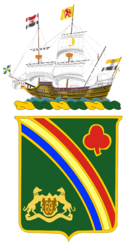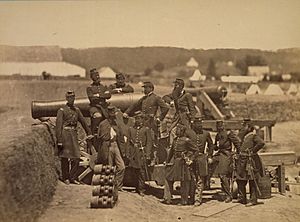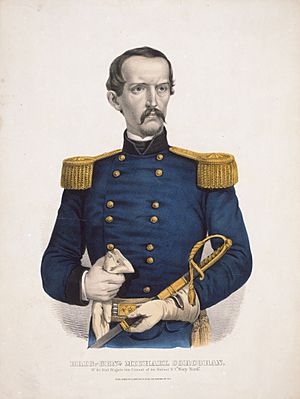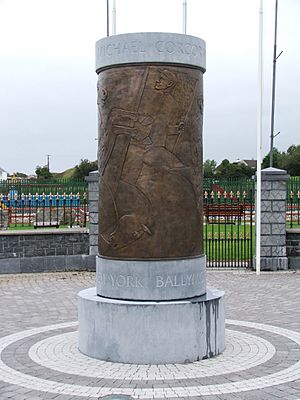Michael Corcoran facts for kids
Quick facts for kids
Michael Corcoran
|
|
|---|---|
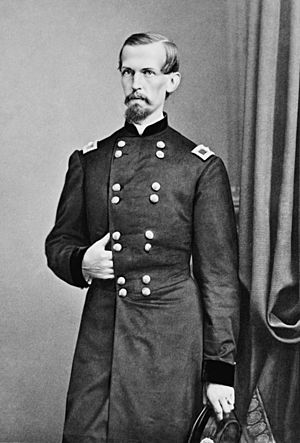
Brig. Gen. Michael Corcoran
|
|
| Nickname(s) | "Mick" |
| Born | September 21, 1827 Carrowkeel, County Sligo, Ireland |
| Died | December 22, 1863 (aged 36) Fairfax, Virginia |
| Place of burial | |
| Allegiance | United States of America Union |
| Service/ |
United States Army Union Army |
| Years of service | 1861–1863 |
| Rank | |
| Commands held | 69th New York Militia, "Corcoran’s Irish Legion" |
| Battles/wars | American Civil War |
Michael Corcoran (born September 21, 1827 – died December 22, 1863) was an important Irish-American general. He served in the Union Army during the American Civil War. He was also a trusted friend of President Abraham Lincoln.
As a colonel, he led the famous 69th New York Regiment to Washington, D.C. He helped defend Washington by building Fort Corcoran. Later, he led the 69th Regiment into battle at the First Battle of Bull Run. After becoming a brigadier general, he created the "Corcoran Legion." This group included at least five other New York regiments.
Contents
Early Life in Ireland and New York
Michael Corcoran was born in Carrowkeel, near Ballymote, in County Sligo, Ireland. He was the only child of Thomas Corcoran and Mary (McDonagh) Corcoran. His father was an officer in the British Army. Through his mother, Michael was related to Patrick Sarsfield, a famous Irish hero.
In 1846, when he was 18, Michael joined the Revenue Police. This group enforced laws and looked for illegal alcohol makers in Creeslough, County Donegal. At the same time, he was part of a Catholic group called the Ribbonmen. This group worked for the rights of Irish Catholics.
On August 30, 1849, he moved from Sligo Bay to the United States. He settled in New York City. There, he worked as a clerk at a tavern called Hibernian House. In 1854, he married Elizabeth, the niece of the tavern owner.
Joining the New York Militia
Michael Corcoran joined the 69th New York Militia as a private soldier. By 1859, he became the colonel, or leader, of the regiment. This regiment was a state militia group made up of citizens, not full-time soldiers. Their job was to help keep public order.
On October 11, 1860, Colonel Corcoran refused to march his regiment in a parade for the 19-year-old Prince of Wales. The Prince was visiting New York City. Corcoran did this to protest against British rule in Ireland. Because of this, he was removed from his command. He was facing a military trial when the Civil War began.
Corcoran also became involved in local government with the Democratic Party at Tammany Hall. He was good at getting Irish people to vote. He became a local leader, helped choose judges, and was an elected school inspector.
Serving in the Civil War
When the Civil War started, the military trial against Corcoran was stopped. He was given back his command. This was because he helped convince many other Irish immigrants to join the Union side. He led the 69th Regiment to Washington, D.C. For a time, they helped build defenses for Washington, including Fort Corcoran.
In July, he led his regiment into their first major battle at the First Battle of Bull Run. During this battle, he was captured by the enemy.
While he was held prisoner, Corcoran wrote, "One half of my heart is Erin's, and the other half is America's. God bless America, and ever preserve her the asylum of all the oppressed of the earth, is the sincere prayer of my heart." Corcoran was also one of the people who started the Fenian Brotherhood in America. This group supported Irish independence.
Corcoran Legion and His Death
After being released from prison, Corcoran returned to the army. He began to recruit more Irish volunteers. He created and led a new group known as the Corcoran Legion. This Legion included several new regiments:
- 1st Regiment: Later became the 182nd New York Volunteer Infantry
- 2nd Regiment: Later became the 155th New York Volunteer Infantry
- 3rd Regiment: Later became the 164th New York Volunteer Infantry
- 4th Regiment: Later became the 170th New York Volunteer Infantry
- 5th Regiment: Later became the 175th New York Volunteer Infantry
Corcoran was put in charge of the 1st Division, VII Corps. He fought in the Battle of Deserted House and took part in the siege of Suffolk. In late 1863, he was given command of a division in the XXII Corps. He returned to help defend Washington.
On December 22, 1863, while riding alone in Fairfax, Virginia, his horse ran away. Michael Corcoran was thrown from the horse and suffered a serious head injury. He died at the age of 36.
Ballymote Memorial
On August 22, 2006, the Mayor of New York City, Michael Bloomberg, unveiled a special monument in Ballymote, Ireland. This monument honors the Fighting 69th Regiment. Philip Flanagan created the sculpture.
The top of the monument says "Michael Corcoran 1827–1863." Around the base, it lists important places: "New York Ballymote Creeslough Bull Run." Underneath the monument is a piece of steel from the World Trade Center. This steel was donated by the family of Michael Lynch, who died there on September 11, 2001. Lynch's family came from County Sligo, just like Michael Corcoran.
See also
- List of American Civil War generals (Union)
- Irish military diaspora
- Irish Brigade
- Irish regiment
- Irish-American Heritage Month


